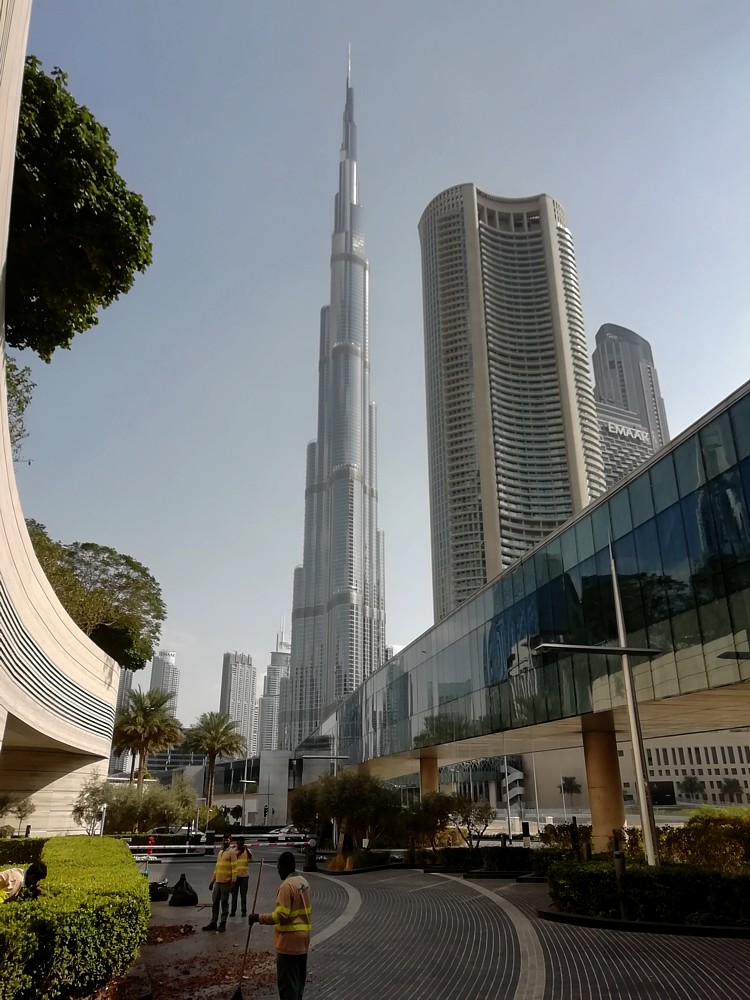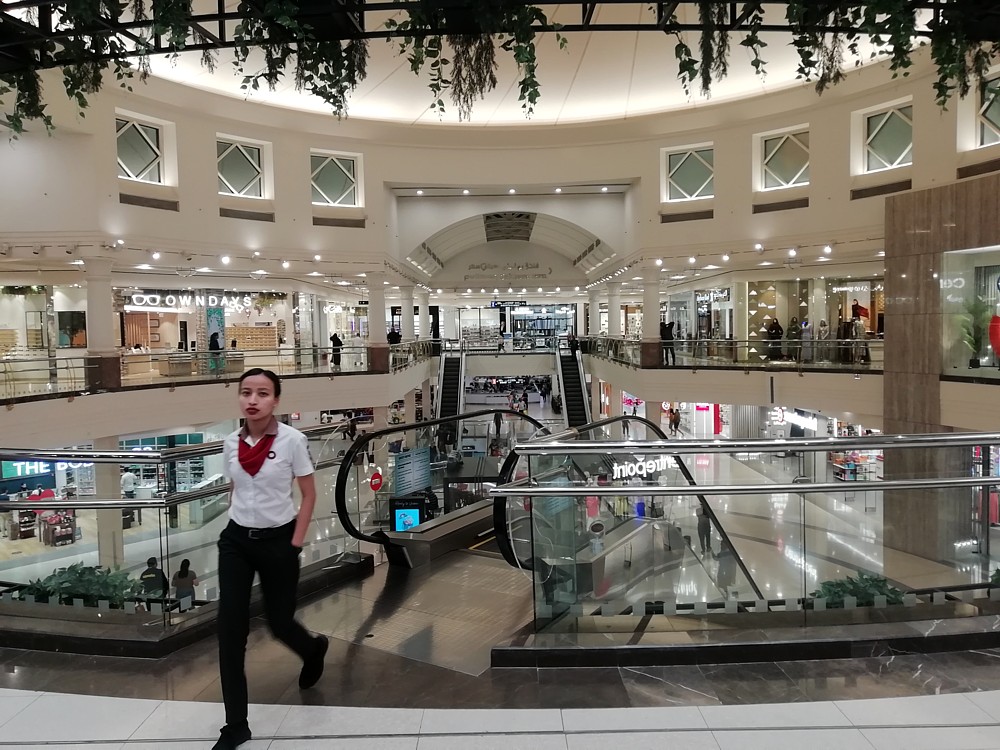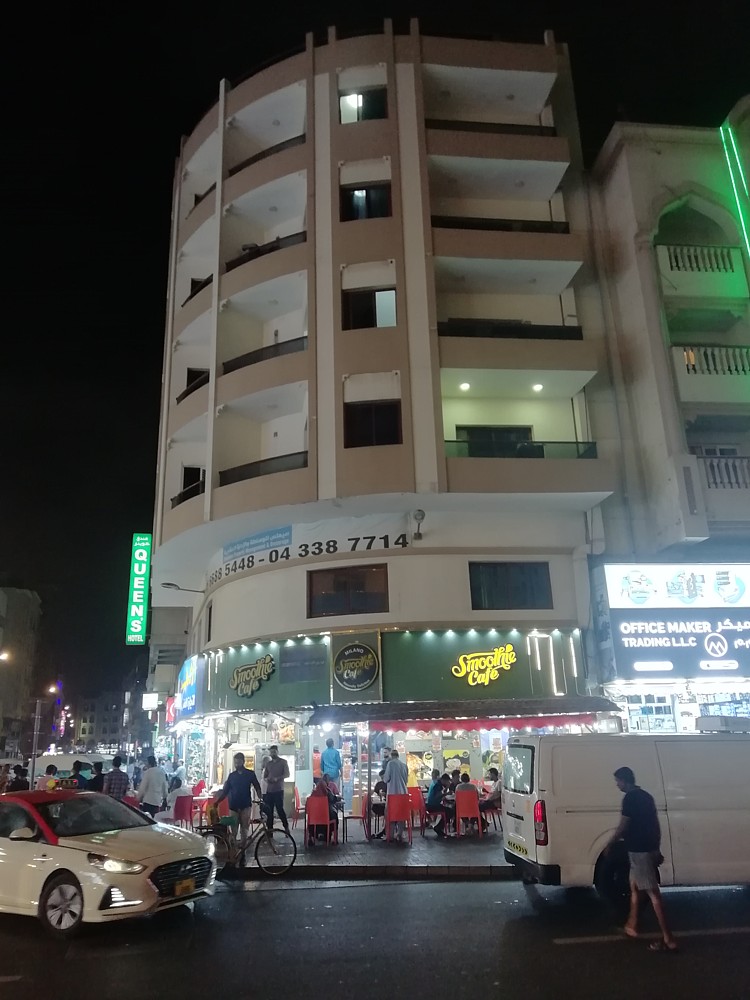Dubai Superlatives: The Power of Excessive Wealth

Who built Thebes of the 7 gates?
In the books you will read the names of kings.
Did the kings haul up the lumps of rock?
And Babylon, many times demolished,
Who raised it up so many times?
In what houses of gold glittering Lima did its builders live?

Sheikh Zayed Road, Dubai, UAE (Photo: Caoimhghin Ó Croidheáin)
Of course, they are very nice cars, apartments, offices and shopping malls. Dubai deals in expensive property and large scales: the tallest building in the world, the Burj Khalifa (829.8m, 2,722ft), the tallest hotel in the world under construction (Ciel), and the foundations laid for the tallest construction in the world - the Dubai Creek observation tower which will be 1.3km (1,300m, 4,300ft) high.

Workers gardening near Burj Khalifa, Dubai, UAE (Photo: Caoimhghin Ó Croidheáin)
Where, the evening that the Great Wall of China was finished, did the masons go?
Great Rome is full of triumphal arches.
Who erected them?
Over whom did the Caesars triumph?
History
I read a comment somewhere that if Dubai were described as a book then the front cover would be Cosmopolitan Magazine and the inside would be The Big Issue (homeless magazine). Starting life as a poor village in the desert beside the sea, Dubai has come on in leaps and bounds ever since. For example, "in 1822, a British naval surveyor noted that Dubai was at that time populated with a thousand people living in an oval-shaped town surrounded by a mud wall, scattered with goats and camels." By the 1930s Dubai was known for its pearl exports but "the pearl trade was damaged irreparably by the 1929 Great Depression and the innovation of cultured pearls. With the collapse of the pearling industry, Dubai fell into a deep depression and many residents lived in poverty or migrated to other parts of the Persian Gulf."
"More than 88.5% of UAE residents are foreign workers, with South Asian migrants constituting 42.5% of the UAE's workforce. [...] These migrants, usually illiterate and from impoverished, rural communities in India, Pakistan and Bangladesh [...] Eager to move to Dubai and begin earning money that they can send home to their families, they take out loans of up to $3000 from unscrupulous recruitment agencies to pay the exorbitant 'visa fees' (which is actually illegal – the recruitment agencies are supposed to cover these fees) and board flights to Dubai, excited for a new life in the glitzy Emirate. When they touch down in Dubai, however, it's a different story. Driven to squalid shanty towns on the outskirts of Dubai, where 45 men share one outdoor bathroom and 10 or more people sleep in a room, their passports are confiscated and they are told that they will actually be working 14 hour days, 6 or 7 days a week, in the desert sun."
The cramped living conditions and low wages has led to high suicide rates too.

City Centre Deira, mall worker, Dubai, UAE (Photo: Caoimhghin Ó Croidheáin)
The International Institute for Global Strategic Analysis has reported that the kafala sponsorship system has played an important part in the exploitation of workers:
"Kafala is a system popular in Gulf countries that gives private citizens and companies responsibility and oversight over workers. The kafala sponsorship system is used to monitor migrant labourers, working primarily in the construction and domestic sectors in Gulf Cooperation Council member states. The kafala system involves withholding labourers' passports to regulate their residency and employment, which gives employers near-total control over migrant workers' salary, living conditions, nutrition, ability to work elsewhere, and even their ability to return home."
The treatment of citizens is very different to the situation for expatriate workers:
"It is estimated that in 2018, there were seven million workers in the UAE alone. Over 90 per cent of the private-sector labour force is comprised of expatriates while UAE nationals continue to be employed in stable and relatively well-paying jobs in the country's vast public sector. Although citizens face restrictions on their human rights, the state offers them a wide range of social benefits, including generous housing benefits, access to free education and medical services, preferential treatment in the workforce and higher salaries."
It was also reported that "domestic workers are exposed to multiple forms of exploitation and violence, including sexual, physical and psychological abuse".
Had Byzantium, much praised in song, only palaces for its inhabitants?
Even in fabled Atlantis, the night that the ocean engulfed it,
The drowning still cried out for their slaves.
The young Alexander conquered India.
Was he alone?
Caesar defeated the Gauls.
Did he not even have a cook with him?
Tourism
Was he the only one to weep?
Frederick the 2nd won the 7 Years War.
Who else won it?
Every page a victory.
Who cooked the feast for the victors?
Every 10 years a great man.
Who paid the bill?
Workers' districts
By far the most interesting areas of Dubai are the areas where the workers themselves live, work, and shop. Deira, for example, is a historic district where the population consists mainly of Pakistan and India natives. Deira has many markets: Murshid Souk, Spice Souk, Deira Covered Souk, and Gold Souk. There are leather shops, shoe shops, supermarkets, barbers, butchers, cafes and family restaurants with dining areas on the city pavements. Compared to the soulless atmosphere of the wealthier districts, Deira is full of life with friendly shop assistants and large groups of African, Indian, Pakistani and Bangladeshi workers and their families enjoying the convivial atmosphere of the restaurants indoors and outdoors.

Deira, Creek, Dubai, UAE (Photo: Caoimhghin Ó Croidheáin)
So many reports.
So many questions.
The Future of Dubai
"The UAE is revisiting its foreign policy goals with the aim of boosting its global trade partnerships and ensuring its security and political stability, by replacing robust military intervention and proxy politics with dialogue and diplomacy.[...] Differences between the UAE on the one hand and Iran, Turkey, and Qatar on the other remain strong. However, the UAE is beginning to realize that the lack of a healthy bilateral dialogue with regional powers will make progress towards de-escalation much harder. The country acknowledges, after a decade of regional conflict and proxy politics, that the divergent policies of regional players should not prevent diplomatic cooperation."
However, in an era of rising temperatures and rising seas, it must be asked how much hotter can Dubai get, and how will this coastal city deal with erosion and flooding? The continued existence of Dubai is dependent on heavy power consumption to maintain air conditioning, trains and services for very large buildings, many more of which are being planned at the moment for future development.

One cannot help but feel that a major collapse of oil prices and/or the economies of the West will have a profound effect on the future of Dubai. As the quote (with as obscure an origin as Dubai itself) that 'the Stone Age didn't end for lack of stones' has noted, new technologies will substantially decrease our reliance on fossil fuels in the future. All these potential changes do not augur well for the future of Dubai's dependence on trade in tourism, oil and gold. If Dubai is ultimately an unsustainable vanity project instigated by a tiny minority of the super rich, as some believe, then the city could be deserted (in more ways than one), and Dubai itself could become the largest open-air museum in the world.
Caoimhghin Ó Croidheáin is an Irish artist, lecturer and writer. His artwork consists of paintings based on contemporary geopolitical themes as well as Irish history and cityscapes of Dublin. His blog of critical writing based on cinema, art and politics along with research on a database of Realist and Social Realist art from around the world can be viewed country by country here. Caoimhghin has just published his new book – Against Romanticism: From Enlightenment to Enfrightenment and the Culture of Slavery, which looks at philosophy, politics and the history of 10 different art forms arguing that Romanticism is dominating modern culture to the detriment of Enlightenment ideals. It is available on Amazon (amazon.co.uk) and the info page is here.

Caoimhghin O Croidheain
Caoimhghin Ó Croidheáin is an Irish artist, lecturer and writer.
Latest from Caoimhghin O Croidheain
- Becoming the Backdrop: The Oppression of Native Americans in Hollywood cinema, and 'Killers of the Flower Moon'
- 'Prophet Song': The secular apocalypse
- Sacred Tree or Paradise Tree? The Christmas Tree and Nature
- Art and Struggle: Olive Trees as Symbols of Palestinian Culture, Food, and Heritage
- Captain Rock: The symbol of a risen people
